|
Sera Monastery |
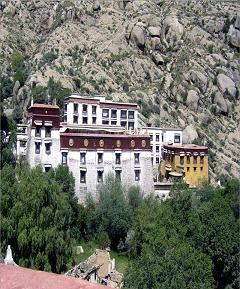 |
'Sera'
literally means 'Enclosure of Roses', is one of the 'great
three' Gelukpa university monasteries of Tibet. The other
two are Ganden Monastery and Drepung Monastery. The
monastery is about 5 km north of the Jokang in Lhasa. It
was founded in 1419, by Jamchen Chojey (Sakya Yeshe), a
disciple of Tsong Khapa. Like the Drepung and Ganden
monasteries, it had three colleges, namely Sera Mey
Dratsang, Sera Jey Dratsang, and Ngagpa Dratsang. Sera Mey
Dratsang was built in 1419 and used to give basic
instruction to the monks, the largest college, Sera Jey
Dratsang was constructed in 1435, and was reserved for
wandering monks, especially Mongol monks. Ngagpa Dratsang,
built in 1559, was a school for the teaching of the
Gelukpa tantras. In 1959, Sera housed more than 5,000
monks. Although badly damaged, it is still standing and
has been largely refurbished. It now houses a few hundred
Buddhist monks. The Sera’s library houses some of the
valuable prayer books. Prayers books in Sera's library
Graduates of Sera Jey College who are known in the west
include, Lama Thubten Yeshe, Geshe Kelsang Gyatso, Lama
Thubten Zopa Rinpoche. |
|
Graduates of Sera Mey college who are known in the west
include, Pabongka Rinpoche—Author of Liberation in the
Palm of Your Hands, Kyabje Trijang Rinpoche—one of the
current Dalai Lama's teachers, Sermey Khensur Rinpoche
Geshe Lobsang Tharchin—former abbot of Sera Mey university
in Bylakuppe. |
|
|
| |
|
Drepung Monastery |
|
Literally
means the 'Rice Heap' monastery', Drepang is also one of
the "great three" Gelukpa university monasteries of Tibet.
Drepung is the largest of all Tibetan monasteries, and
indeed at its peak was the largest monastery of any
religion in the world. Jamyang Chojey, who was a direct
disciple of Je Tsongkhapa, the founder of the Gelukpa
school, founded it in 1416. It is located on the Gambo
Utse mountain, 5 kilometers from the western suburb of
Lhasa.
At its
largest, before the Chinese invasion of Tibet in 1959, the
monastery housed fifteen thousand celibate monks and was
known for the high standards of its academic study. |
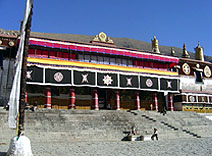 |
|
Young monks of Drepung is
divided into what are known as the seven great colleges - Gomang, Loseling, Deyang, Shagkor, Gyelwa or Tosamling,
Dulwa, and Ngagpa. Routines in Drepung monastery is
comprised of four parts: education, religious rites,
education administration and sundry affairs. It can be a
somewhat useful analogy to think of Drepung as a
university along the lines of Oxford or the Sorbonne in
the middle ages, the various colleges having different
emphases, teaching lineages, or traditional geographical
affiliations. Today the population at the monastery is
much smaller with merely a few hundred monks, due to
population capping enforced by the Chinese government.
|
|
|
| |
|
Samye Monastery |
|
Situated about 40km
to the west of Tsedang across the Tsangpo River, it is the first
monastery built by King Trisong Detsen in the 8th century.
During the reign of this king, the birth of monk community
began. This monastery is marvelous blend of three distinctive
architectural styles that of India, China and Tibet. These three
styles symbolize the source, stability and spread of the
Buddhist faith in the respective areas. |
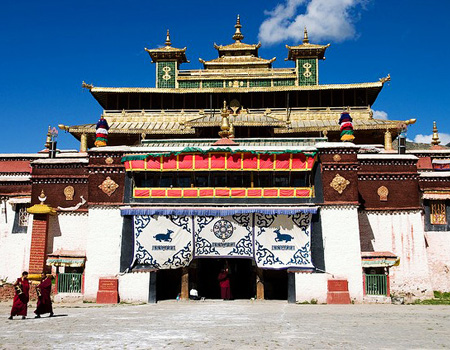 |
|
|
|
The Palkhor Monastery |
|
The Palkhor
Monastery also called Palcho Monastery it is quite
different from other monasteries of Tibet. Structured as a
typical Tibetan Buddhism monastery it was built in 1418
and has remarkably remained intact and unscathed to this
day. It lies about 230 kilometers south of Lhasa and 100
kms east of Shigatse at the foot of Dzong Hill. The most
remarkable feature of this monastery is that it is the
only monastery that houses monks from different orders.
The monks from the Gelugpa, Sakyapa and Kahdampa orders
stay in this monastery with noticeable harmony. Although
they once quarreled and fought, the different orders
eventually discovered a way to get along with each other.
As a result, its oblation, architecture style, deities
enshrined and murals are very special.
The Main Assembly Hall of Palkhor Monastery, Tshomchen,
was built between the end of the 14th century and the
beginning of the 15th century. It is a three-storey
structure. The ground floor has a chanting hall with 48
columns that are ornamented with old silk "thangkas". It
also houses an eight- meter high bronze statue of Maitreya
Buddha, which is gilded and made from 1.4 tons of |
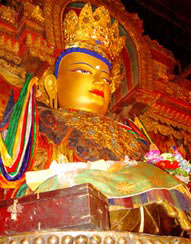 |
|
bronze. On the second floor of
monastery there are chapels belonging to “Bodhisattva Manjushri" and "Arhats" from the Ming dynasty. Among these
the Arahat chapel is quiet popular throughout Tibet. The
roof of monastery also holds chapels which preserve a
collection of 15 "mandala" murals. These are three meters
(ten feet) in diameter. There are also some other
attractive features in monastery like the collection of
about 100 robes and costumes worn in Tibetan opera. These
costumes were made of silk, embroidery and tapestry and
belong to the era of Ming dynasty and the Qing dynasty.
|
| |
|
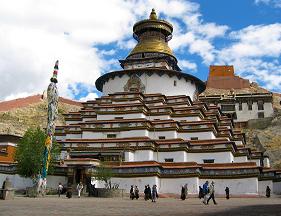 |
The
Palkhor Monastery is also popular for its tower,
Palkhor Tower, also called the Ten Thousand Buddha
Tower. It is the calling card of Palkhor Monastery and
the most important building in this monastery. The
tower houses about 100 family halls for worshipping
Buddha, one over the other. It has 10,000 figures of
Buddha in the Buddhist shrines, murals and family
halls which provides it the name the Ten Thousand
Buddha Tower.
Another
significant feature of Palkhor Monastery is "Kumbum
Stupa" which is considered the symbol of the
monastery. This pagoda style stupa
consists of hundreds of chapels in layers and houses
about a hundred thousand images |
|
of various Buddhist icons. In total,
there are about 3,000 statues, so it is called "Myriad
Buddhas Stupa" also. It was an important centre of the Sakya school of Tibetan Buddhism and still considered
as one of the most outstanding and sacred places of
Tibet. This graceful structure is one of the most
visited places in Tibet. |
|
|
|
| |
|
Tashilhunpo Monastery |
|
Tashilhunpo Monastery is located at the west part of the
Shigatse city and about 250 km away from the capital of
Tibet Lhasa. Situated on the foot of Drolmari or Tara’s
mountain, it is one of the huge Monasteries of Gelugpa (or
Yellow Hat Sect) in China and the biggest Tibetan Gelugpa
Buddhism monastery in back Tibet area. Standing on a
whooping area of around 300,000 sq. m it is also called the
Heap of Glory. It is known as a seat of the Panchen Lama who
is considered to be the second most important religious
leader of Tibet.
Founded by the
first Dalai Lama in the year 1447 the monastery
significantly expanded by the fourth and successive Panchen
Lamas. The Monastery covers an area of nearly 300,000 square
meters. |
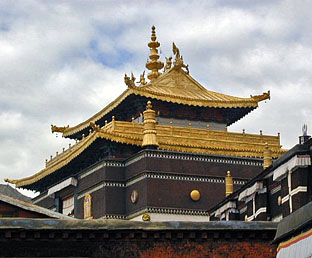 |
|
The main
structures found in the Monastery are The Maitreya Chapel, The Panchen Lama's Palace and The Kelsang
Temple. Tashilhunpo is the seat of the Panchen Lama since
the Fourth Panchen Lama took charge in the monastery, and
there are now nearly 800 lamas. When seen from entrance the
gran d building of monastery enchants the visitor with its
golden roofs and white walls. The Thangka Wall built by the
First Dalai Lama in 1468 is outstanding with its nine floor
high structure. The wall displays the images of Buddha on
the 14th, 15th and 16th of May every year following the
Tibetan Lunar Calendar. |
| |
|
The west side of
the monastery holds Maitreya Chapel, which houses the
biggest statue of a sitting Maitreya Buddha. The statue
stands 26.2 meters (86 ft) high and is adorned with gold,
copper, pearl, amber, coral, diamond and other precious
stones. About nine hundred artisans handcrafted this statue
in nine years. The Maitreya chapel has been divided into
five floors. There is wooden staircase in the chapel that is
used to visit the different floors of the chapel. One can
more clearly see the statue from the upper floors of the
chapel.
In the east of
the chapel lies the Stupa-tomb of the Tenth Panchen Lama.
Built in 1993 and enclosed by 1,354 pounds (614 kg) gold,
868 precious stones and 246,794 jewels, the Stupa-tomb is
the most splendid and expensive mausoleum in China since the
1950s. The Panchen Lama's Palace built during the reign of
the Six Panchen Lama stands nearby the Stupa-tomb, but it is
not opened for visitors. To the east of the Panchen Lama's
Palace lies the first stupa-tomb of Tashilhunpo. This stupa-tomb
belongs to the Fourth Panchen Lama who is one of the most
famous Lamas in Tibetan history. He was also the teacher of
the Fifth Dalai Lama. Ornamented with gold and silver this
magnificent stupa-tomb was built in 1662.
The another
significant building in Tashilhunpo is the Kelsang Temple.
It is one of the oldest and biggest buildings in Tashilhunpo.
It is a colossal compound. It has a Main Chanting Hall where
the lamas learn the sutras and listen to the Panchen Lama's
sermon. On the back end of the hall lies a 5 meters (16 ft)
high statue of Sakyamuni. It is said that a part of
Sakyamuni's relics was placed in it. There are two chapels
situated on both sides of the Main Chanting Hall. The left
one is devoted to Tara, the goddess who is believed to be
the avatar of Avalokitesvara. The chapel contains the
statues of White Tara (which is seated in the middle) and
two Green Taras on each side. The right chapel is devoted to
Maitreya Buddha. The chapel houses the statutes of Maitreya
Buddha, the Avalokitesvara and Bodhisattva Manjusri. The
Great Courtyard of the Kelsang Temple is used by the lamas
for practice and debate. Thousands of images of Sakyamuni in
different postures and expressions cover the wall around the
courtyard.
In addition to
the majestic palace and gigantic statues, the Tashilhunpo
Monastery also treasures distinctive murals. These murals
are notified for their variety of shapes, brilliant colors
and fine painting and are considered to be another
masterpiece of Buddhist art. Monastery also houses some rare
sutras, thangka, china and glass services of the Ming and
Qing Dynasties. Thus, Tashilhunpo Monastery helps you to
explore the history and society of Tibet. |
|
|
| |
|
Rongbuk Monastery |
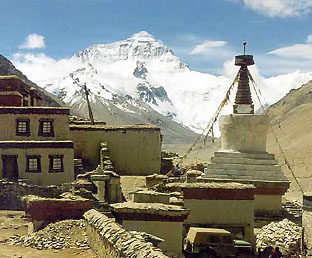 |
Rongbuk
Monastery is one of the highest monastery in the
world. Located at the elevation 4800 meters it is the last
inhabited spot before Everest Base Camp. Rongbuk monastery
is situated in Basum Township, in Shigaste Prefecture of the
Tibetan Autonomous Region, China. When seen from this
monastery Mt. Everest appears like a lofty pyramid
surrounded by mountains that touch the sky. When a pile of
the thick clouds float above the peak on sunny days, it
creates the magical site of 'The Highest Flag Cloud in the
World'. The monastery is accessible today via vehicle by
means of an undeveloped road.
Rongbuk
Monastery was built by a local lama in about 1899. It was
built in an area of meditation huts that had been in use by
monks and hermits for over 400 years. |
|
Hermitage meditation caves dot the cliff walls all around
the monastery complex and up and down the valley. |
| |
|
Many walls and
stones, carved with sacred syllables and prayers, line the
paths. Zatul Rinpoche, the lama who founded this monastery
was much respected by the Tibetans. In olden times, the
Monastery was a active centre of the teachings. It was a
site of special pilgrimage during the annual ceremonies with
masked dancers. Throngs of the faithful would come from far
and wide—some from Nepal and Mongolia—and sit on every level
of all the many-tiered flat roofs of the monastery to watch
the masked dancers in the great open courtyard. Cymbals
clanged amid the ceaselessly overlapping thunder of the long
Tibetan trumpets played in relay to accompany the monk
dancers in their ritual. These ceremonies were shared with
the satellite monasteries across the Himalaya also founded
by the Rongbuk Lama. The ceremonies survive to this day,
notably at the Sherpa monastery at Tengboche. The monastery
houses a vast collection of books and costumes, which had
been taken for safekeeping to Tengboche, were lost in a 1989
fire.
The monastery
has five-tier building, but only two floors are in use now.
In the frontispiece of the main hall, were forfeited the
statues of Sakyamuni and Geru Rinpoche. There is a
beautiful, large, round chorten, a reliquary with religious
significance embedded in its terraced structure and crown of
emblems of the sun and moon, symbolizing the light of
Buddha's teaching. The chorten dramatically marks this last
human dwelling place before one heads up the stark valley to
Base Camp. Walking forward from Rongbuk Monastery, you can
see the famous Rongbuk Glacier Zone, which is the largest
among all the hundreds of glaciers formed around the Mt.
Everest. The three glaciers north of the Mt. Everest flow
south and assemble at a river traversing the foot of the
monastery. This is called 'Rongbuk River', and the water
here is extremely cold.
In Rongbuk
monastery both the monks and nuns reside and celebrate the
Buddhist festivals together. Monastery hold the three days
Saka Dawa Festival which is held to celebrate the birth of
Sakyamuni. During the play, many monks disguise themselves
as Rabbis and dance many scenes one after another, and most
scenes portray different characters and clothing. Another
Tibetan festival is held in the month of December of
Tibetan Calendar to placate wandering ghosts, and monks
wearing masks also perform this grand ceremony. |
|
|
|
|

